Coronavirus Today: A new resource for parenting through a pandemic
- Share via
Good evening. I’m Amina Khan, and it’s Friday, April 2. Here’s the latest on what’s happening with the coronavirus, plus ways to spend your weekend and a look at some of the week’s best stories.
Change is coming quickly for Californians. Indoor live events will return later this month. People who are fully vaccinated now have the CDC’s go-ahead to travel. Even that quintessentially Californian experience of wine tasting looks a lot different.
But perhaps for no one is change coming faster than for families of school-age children and teenagers. Campuses throughout the Golden State are finally beginning to welcome students back to campus after a year of pandemic-triggered closures. While the return to classrooms could mark one major milestone in the return to normalcy, there’s no denying that the past year has rewired families’ relationships to education, parenting and child care.
My colleague Sonja Sharp has spent the past year exploring the issues tha families with young children face during a pandemic, disentangling for readers the thicket of law, labor, funding and bureaucracy surrounding child care and education in the state. Now, as campuses begin to open their doors to more students, she’s writing a newsletter, called 8 to 3, to help California families navigate a kaleidoscope of questions. You can sign up here.
Sonja will draw on her experience as a reporter, a mom to a 5-year-old and a kindergarten-through-UC Berkeley graduate of California’s public schools. (She and I worked at the Daily Californian at the same time. Go Bears!) The newsletter will be sent every Monday evening, its first edition this coming one. I chatted with Sonja about what’s ahead.
I was going to risk repeating a question you’ve heard before and ask: Why now? But the more I thought about it, I wondered: Why not before?
That’s a great question. Why wasn’t this a matter of national interest before the pandemic? It is so defining of our lives. If you are a woman in the workforce and you think you might ever have a child, you have probably thought about: Where will they go to school? How will I balance it with my work? Where will I find daycare? How will I pay for it? How can I make the hours of my demanding job? [Just before the pandemic] women were more than 50% of the workforce. And so this is a huge question.
Do you feel like the pandemic has shifted any of that child care and parenting burden to men?
I wish I thought that. Look at what has happened to women in the workforce. If the pandemic had shifted the responsibility within individual households from women to men, I don’t think we would have seen a mass exodus of women from the workforce when the majority of K-12 schools did not reopen in the fall. I think what the pandemic has revealed is that we were already doing this work. I don’t think we’ve ever had such a frank conversation about it.
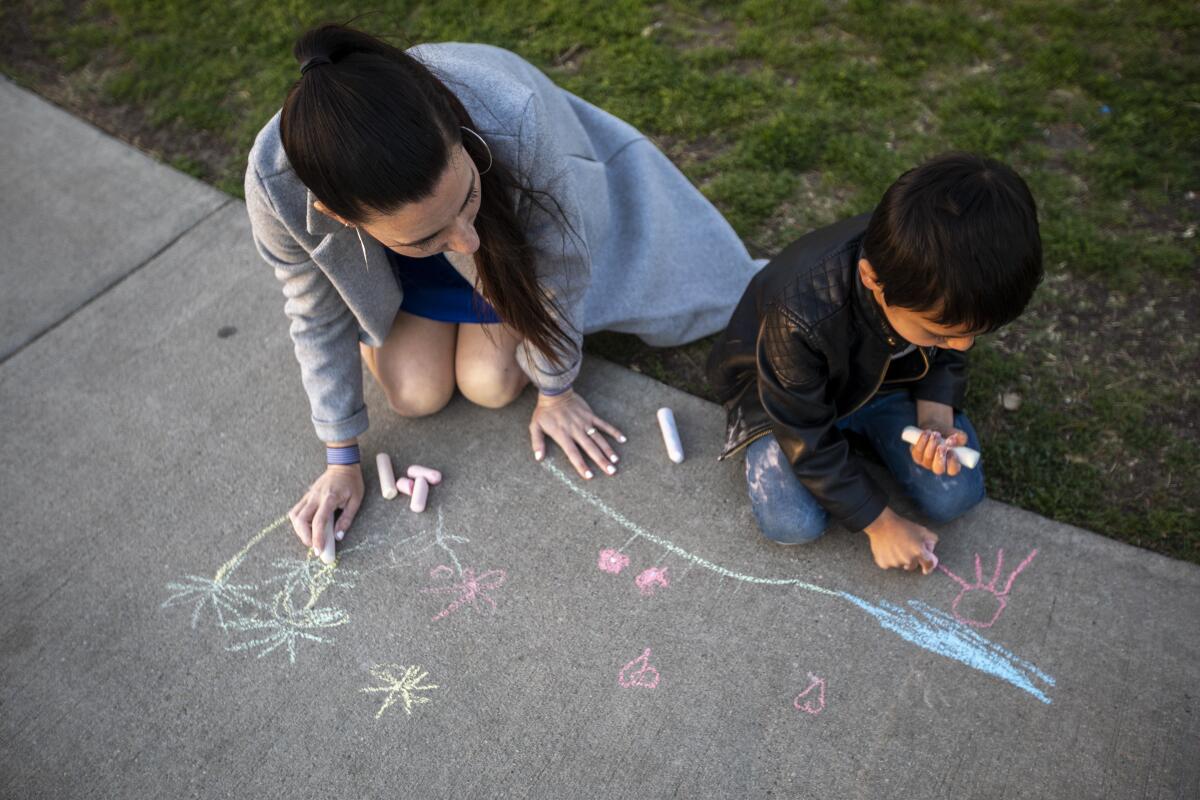
What are you hoping the newsletter will accomplish? Is it a guide for parents through this overwhelming situation? Or is it a way to show parents struggling with these challenges that they’re not alone?
I think so many people just want to be validated. I feel like there’s an opportunity now to say: It’s not just in your head, it’s not just you, there are these national-level statistics and facts to bring light to your situation.
Even if you work graveyard shifts, we all know “9 to 5” means work. And I like “8 to 3” as a concept because it also evokes labor — all this labor that we do, whether you’re an educator, a parent, both — that doesn’t get recognized as labor.
So that’s the way I approach a lot of this. Whose labor are we looking at when we look at these issues? Who has to carry this, along with everything else they’re carrying, especially at a difficult moment like this?
And how do we value it?
And how do we value it — or not value it.
I think it’ll be interesting to see what the transition back to school looks like for students of different ages and backgrounds. My niece is 8 and a great student and very social, and she can’t wait to get back to class. On the other hand I’ve heard of some high school students who are thriving with distance learning and don’t necessarily want to go back full time. And then there are the kids and teens who didn’t have the necessary resources and support for distance learning who have really suffered.
Right. And I think that’s just going to be a story for so much longer. What do we do for kids who were really harmed during this period of isolation? And what do we do for the kids who really thrived? How do we find something just and equitable and fair and good for all the different experiences? I don’t know. There’s a lot of radical ideas going around and I don’t know which will find favor.
It doesn’t seem like there are any easy answers here.
I don’t think there are. There isn’t one experience. There’s so much nuance — and so much pain and agony parents go through in trying to make the right decisions for their kids.
I really hope also that readers will come with the understanding that we have reporters on our education team — which is excellent — whose job it is to understand the forest, to understand the entire ecosystem and to be able to talk about how the system is running. I am really looking at the trees there in front of us.
By the numbers
California cases and deaths as of 5:28 p.m. Friday:

Track California’s coronavirus spread and vaccination efforts — including the latest numbers and how they break down — with our graphics.
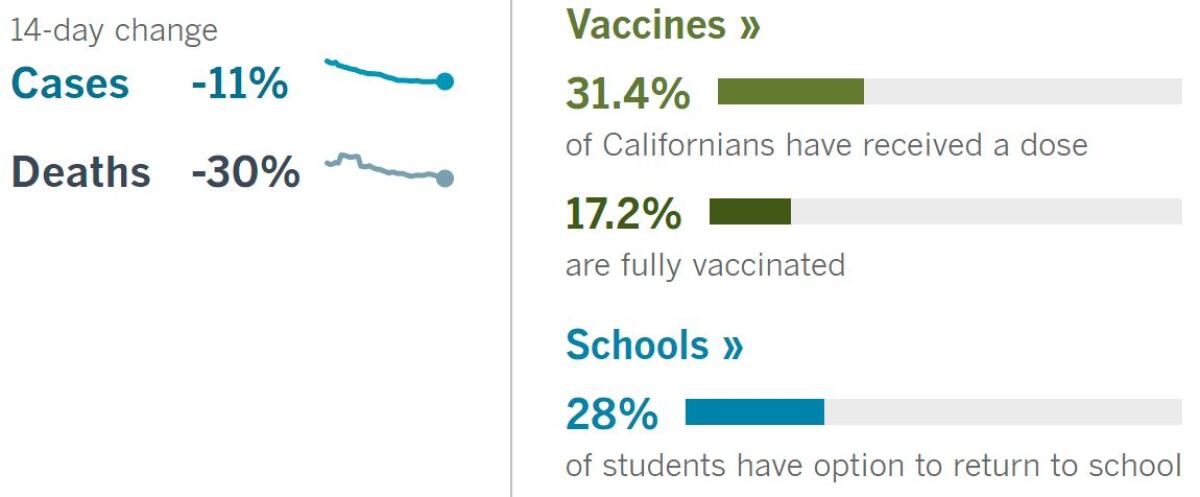
See the current status of California’s reopening, county by county, with our tracker.
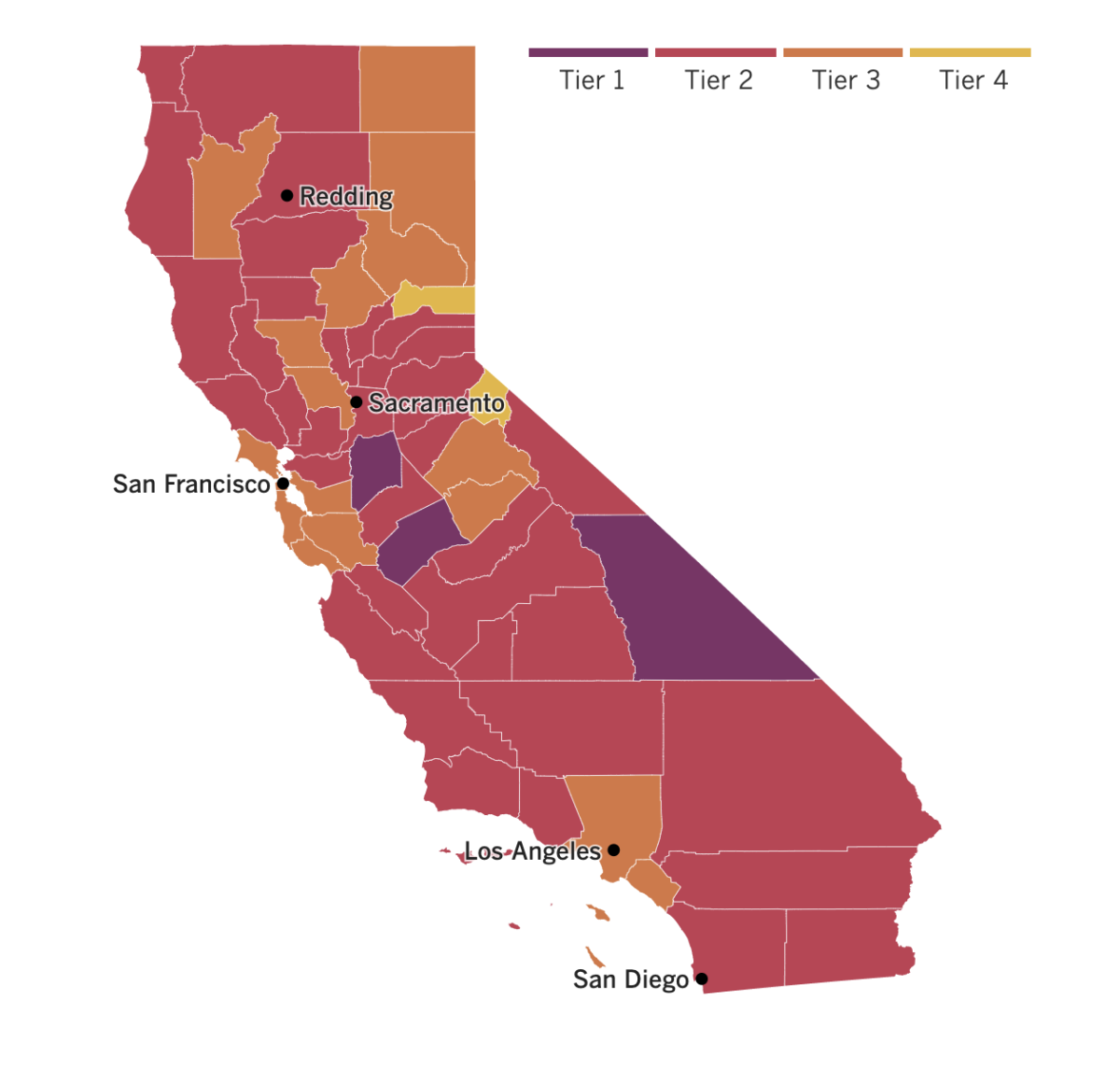

What to read this weekend
Thirteen lessons from the pandemic
Like many during the pandemic’s early days, columnist Mary McNamara tangled with plenty of fun emotions: fear, guilt, powerlessness and anxiety. She’d check her children’s breathing patterns, obsessively check a COVID-19 map and generally just soak in sleepless, existential dread.
To fight the resulting exhaustion, she put together a bucketful of plans in the early days: relearn French; reacquaint herself with her favorite poets, playwrights and free weights; tame her feral garden; and learn how to make her own candles, among others. She even bought a sewing machine. Maybe she’d make some face masks and some curtains.
Spoiler alert: These plans did not work out. “If anyone needs a sewing machine — fully threaded and never used! — please let me know,” she adds.
Instead, McNamara graces us with a brief list of lessons learned during her year at home. Among them: Dogs fart all the time. “Clutter fairies” exist. And everyone believes they are the only person who puts new toilet paper on the roller. It’s a delightful list, and you may be able to relate. Read the whole piece here.
‘Reinforcing a lot of the trauma’
As anti-Asian violence has worsened during the pandemic, many Asian Americans have been reckoning with concomitant mental health crises.
Linda Yoon, a Korean American psychotherapist, says she and the other therapists in her Los Angeles-area practice were virtually flooded with calls and emails from would-be clients in the wake of the Atlanta-area spa shootings two weeks ago. Ninety percent of them were Asian people mentioning the shooting or racial trauma, and their calls came from not just L.A. but across the country. The demand was far higher than the therapists could hope to meet. “That’s been hard ... we had to turn some Asian clients away,” Yoon said.
The Atlanta-area shootings amplified the longtime mental health crisis in Asian American and Pacific Islander communities after a year of anti-Asian violence and grief over COVID-19 deaths, my colleague Marissa Evans reports. Experts and advocates say these events also helped expose other shortcomings in the healthcare system particular to Asian Americans.
“It’s just making a lot of mental health challenges worse,” said Mandy Diec, California policy director for the Washington, D.C.-based Southeast Asia Resource Action Center. “It’s really nothing new, but it’s something reinforcing a lot of the trauma, and it’s unfortunate that the biggest problem is that we live in a healthcare system that doesn’t account for the needs of our community.”
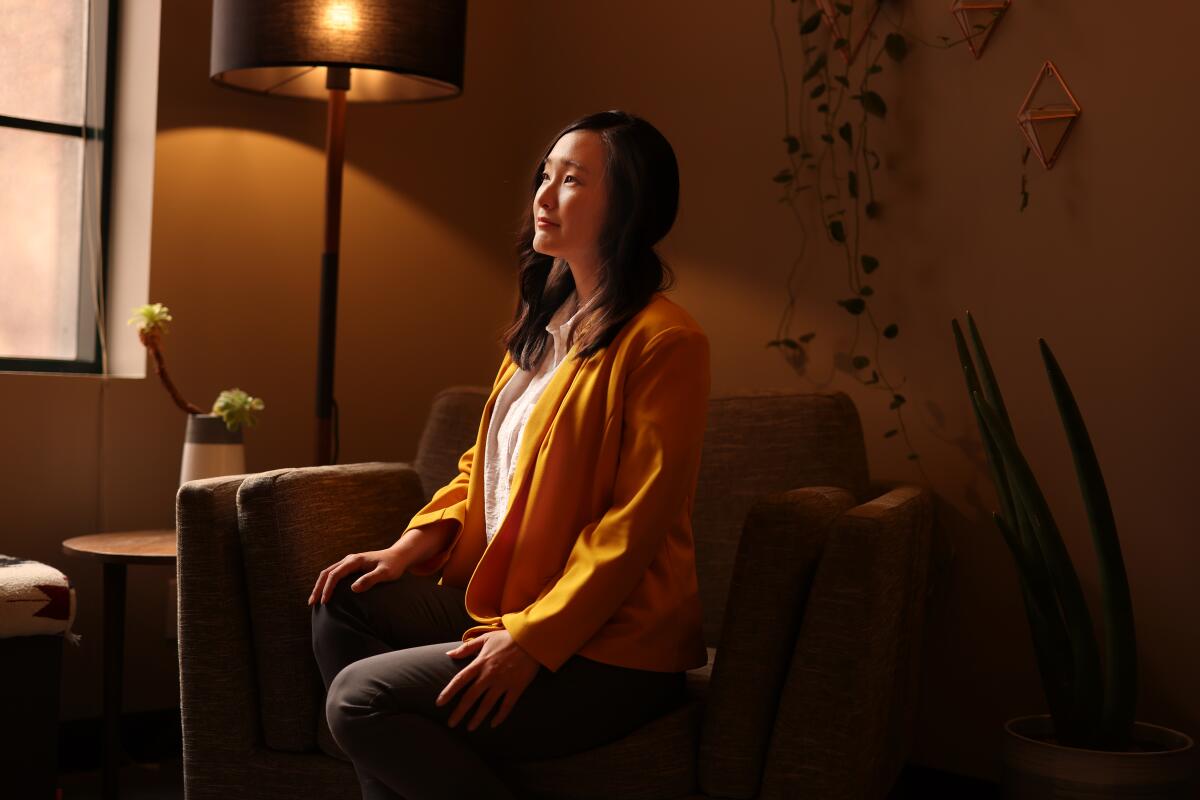
Vaccine equity for trans people
While California has worked hard to distribute vaccine doses more equitably, columnist Erika D. Smith highlights a group of people whose hesitancy deserves broader recognition: the transgender community. “There is a fair amount of skepticism, particularly within the trans and gender-nonconforming community, about COVID vaccinations,” said Jury Candelario, director of APAIT, formerly known as the Asian Pacific AIDS Intervention Team. “Some of our clients have just declined.”
Trans people tend to get missed in the push for health equity because they crisscross multiple demographics, which means their particular brand of vaccine hesitancy isn’t getting addressed. This is especially true among Black and Latino trans people, such as Sasha Morehead, who doesn’t want to get vaccinated because she believes “they are just testing it on people.”
The belief in such conspiracy theories stems from a unique mix of mistrust of government, medical research and the healthcare system as a whole that many trans people have developed in reaction to healthcare experiences that can be dehumanizing or worse.
Kyle Le Grand believes she came down with COVID-19 while she was homeless and living in a car with her partner. She has now been vaccinated, but she worries about other vulnerable trans women who are still living on the streets, especially those who are doing sex work and who don’t have easy access to vaccination sites. “There needs to be more outreach,” she said. “There needs to be more trust building, and there needs to be like something geared specifically for those communities instead of just, ‘Get the vaccine.’”
The nurses saving Californians, one vaccine at a time
Reshicka Upshaw wakes before dawn to get her kids ready for school. She makes sure their teeth are brushed, their clothes clean, their homework done. Sometimes she prays with them before she starts work. And she does it all from more than 2,000 miles away.
Upshaw’s children live in Cincinnati. Her job is at a COVID-19 vaccination site in hard-hit San Bernardino County. The 40-year-old mother of eight is a travel nurse, one of many who have flown in from Detroit, Syracuse, N.Y., Dyersburg, Tenn., and beyond in order to assist California’s overburdened healthcare system during the pandemic. They have seen California, the fifth-largest economy in the world, in its most fragile state.
As of March 15, there were nearly 2,000 travel nurses deployed by the California Department of Public Health across the state to help with vaccinations. “It’s just what we needed. We wouldn’t have been able to do it without them,” said Melissa German, public health program manager for San Bernardino County. But to help California, many nurses have had to leave behind their homes, and sometimes their families. Upshaw didn’t tell her siblings she was going until she was on the plane.
It has been a rough year for the family. In June, about 30 members — her eight children, five of her siblings, cousins and Upshaw herself — tested positive for the coronavirus. “By the grace of God, all of us survived,” she said. In August, Upshaw told her family that she wanted to work as a travel nurse. It had been a lifelong dream to travel and help people across the country. My colleague Brittny Mejia chronicles her journey here.
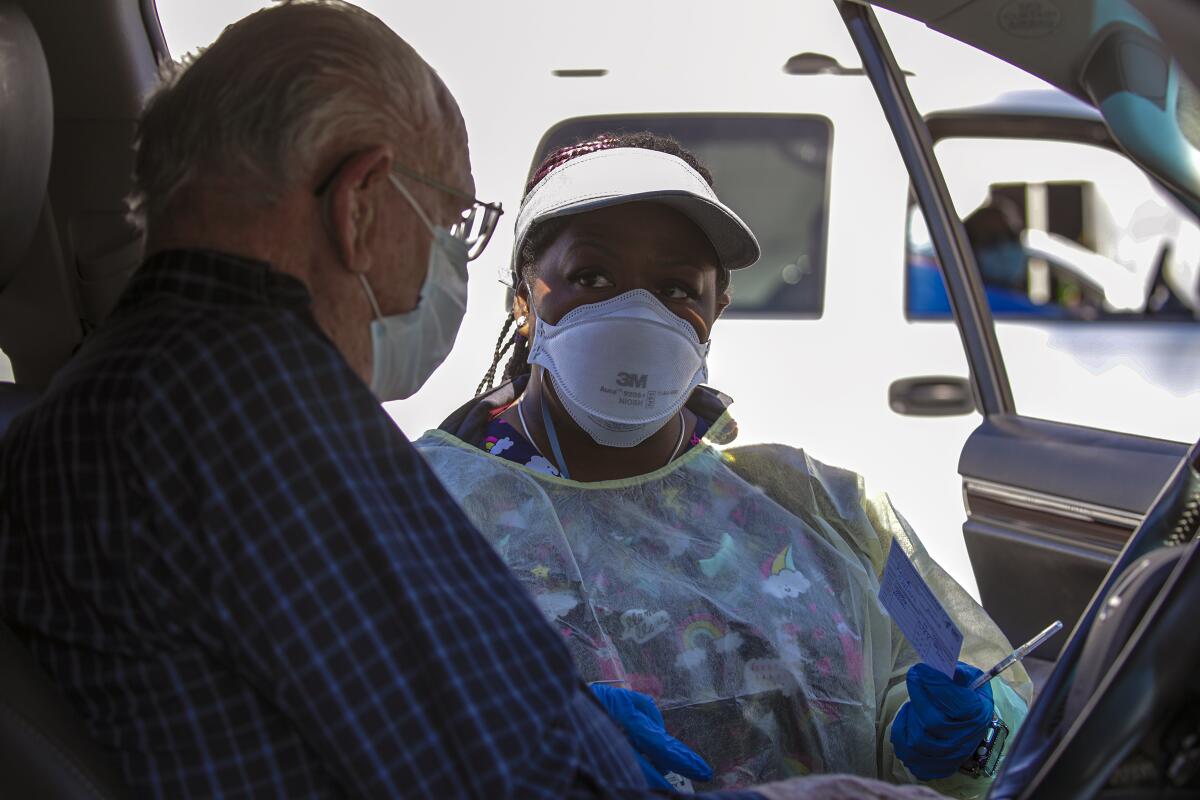
Hesitant high schoolers
High school students have pushed their way through a year of isolation as the pandemic shuttered school campuses. They’ve lost a year of milestone experiences — proms, sports games and friendships. Studies have pointed to a rise in mental health problems.
But in spite of all this, many high school students are opting to finish the year online. In the Los Angeles Unified School District, the second largest in the nation, 84% are staying at home, with a similar pattern emerging in other area school districts.
Take Los Angeles High senior Isabell Diaz, who’s gotten used to her new routine. She rolls out of bed half an hour before her 9 a.m. class. On breaks, she steps away from the screen to eat breakfast or complete chores. She has figured out how to juggle online assignments and virtual club meetings. So when she learned that her school would open in late April, she had mixed feelings about it.
“My initial thought wasn’t ‘Oh my gosh, yay.’ It was ‘OK, are we sure about this? How is this going to work?’” the 17-year-old said. Then fear set in — she remembered how COVID-19 had hit her father and two sisters hard in December. When she realized she would take all her classes online while stuck in one classroom all day, she knew her answer: No.
My colleague Melissa Gomez spoke to a host of teens about their ambivalence. Read the full story for a window into how they are feeling.
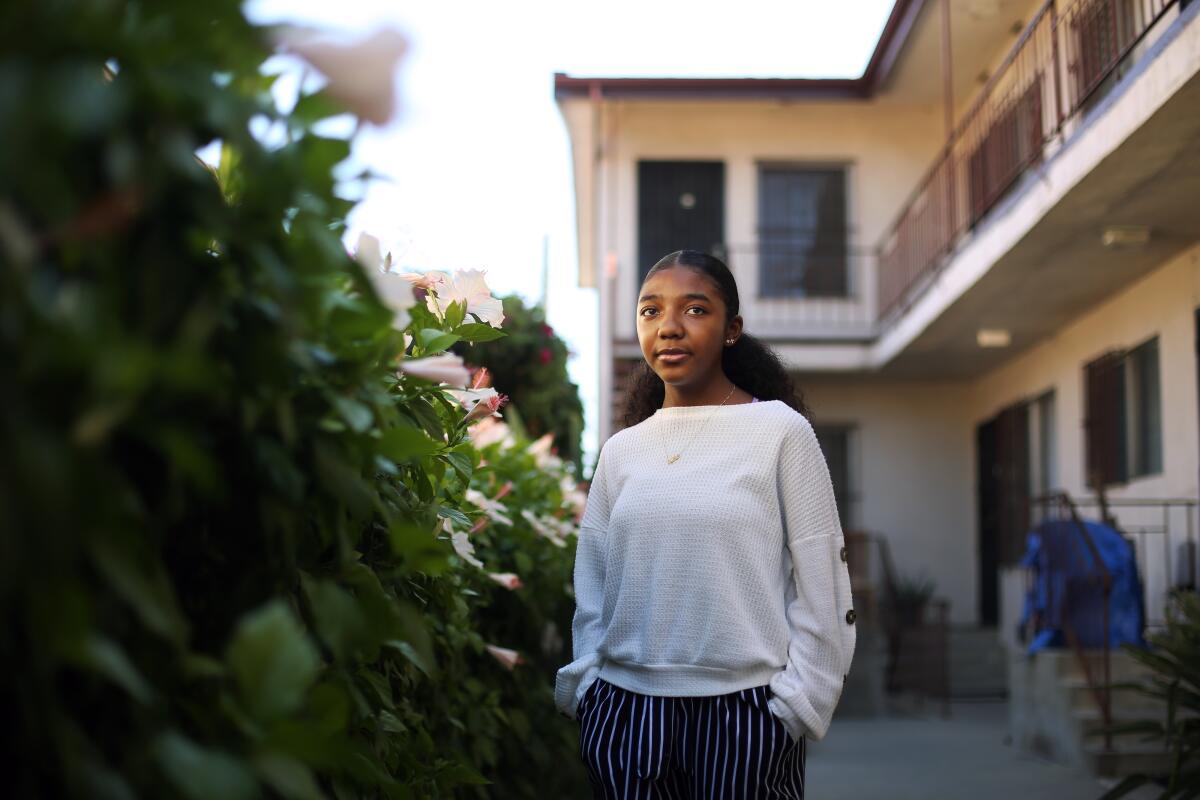
Your support helps us deliver the news that matters most.
What to do this weekend
Get outside. Go stargazing in the desert during International Dark Sky Week, April 5 to 12, which aims to raise awareness about the downside of light pollution. Visit an official dark sky park east of L.A. — Joshua Tree and Death Valley national parks plus Anza-Borrego Desert State Park — to see what you’re missing in the night sky. Subscribe to The Wild for more on the outdoors.
Watch something great. Our weekend culture watch list includes “Broadway Backwards,” in which a slate of Tony winners from Bernadette Peters to Glenn Close put gender-bending twists on classic show tunes in this benefit for Broadway Cares/Equity Fights AIDS. And in his Indie Focus newsletter’s roundup of new movies, Mark Olsen highlights “Shiva Baby,” a comedic pressure cooker in which a college senior forced to attend the shiva for an aunt runs into both her ex-girlfriend and the sugar daddy she sleeps with for extra money.
Eat something great. Ben Mims graces us with some dishes fit for spring, such as the verdant spring pea salad with pistachio pipian and a sweet but tart strawberry and rhubarb crisp. Sign up for our Cooking newsletter for more refreshing recipes.
Go online. Here’s The Times’ guide to the internet for when you’re looking for information on self-care, feel like learning something new or interesting, or want to expand your entertainment horizons.
The pandemic in pictures
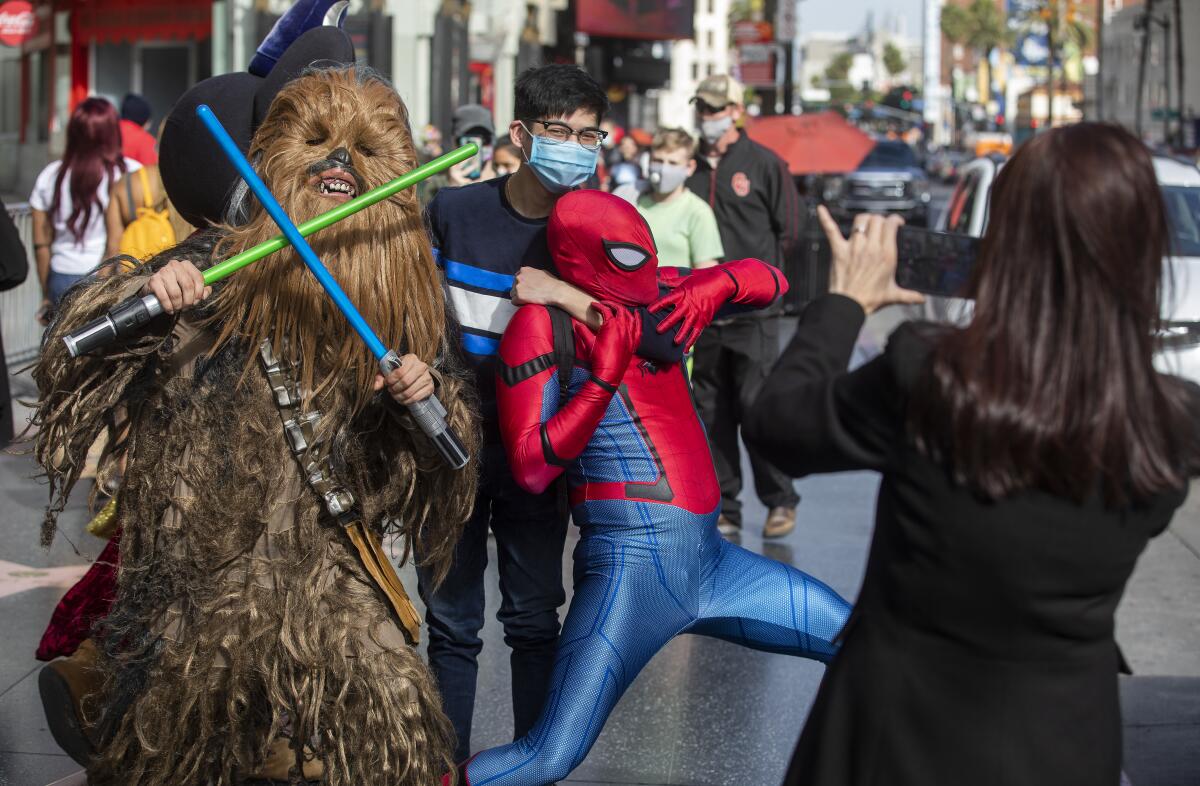
Now that counties across Southern California have moved into less restrictive tiers of the state’s reopening plan, and with vaccination rates on the rise, movie theaters, museums, theme parks and other institutions are beginning the process of reopening — within pandemic guidelines.
Times entertainment photo editor Ken Kwok dispatched photographers Jay L. Clendenin, Allen J. Schaben, Mel Melcon, Genaro Molina and Myung J. Chun to document this singular spring awakening. This photo, where a masked tourist poses on Hollywood Boulevard with Chewbacca and Spiderman, really captured the moment.
Resources
Need a vaccine? Keep in mind that supplies are limited, and getting one can be a challenge. Sign up for email updates, check your eligibility and, if you’re eligible, make an appointment where you live: City of Los Angeles | Los Angeles County | Kern County | Orange County | Riverside County | San Bernardino County | San Diego County | San Luis Obispo County | Santa Barbara County | Ventura County
Practice social distancing using these tips, and wear a mask or two.
Watch for symptoms such as fever, cough, shortness of breath, chills, shaking with chills, muscle pain, headache, sore throat and loss of taste or smell. Here’s what to look for and when.
Need to get tested? Here’s where you can in L.A. County and around California.
Americans are hurting in many ways. We have advice for helping kids cope, resources for people experiencing domestic abuse and a newsletter to help you make ends meet.
We’ve answered hundreds of readers’ questions. Explore them in our archive here.
For our most up-to-date coverage, visit our homepage and our Health section, get our breaking news alerts, and follow us on Twitter and Instagram.




